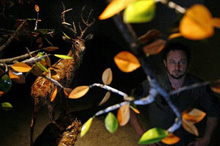Translating the Venice Biennale to New Orleans
by Doug MacCash, THE TIMES-PICAYUNE

Srdjan Loncar poses with two pieces of his sculpture. Photo by Ted Jackson.
The Venice Biennale is just like any avant-garde art exhibit. Everything is a bit strange. Some things are beautifully strange, some fascinatingly strange, some incomprehensibly strange, some horribly strange.
The big difference is the scale of the strangeness.
Canadian artist David Altmejd didn’t sculpt an 8-foot-tall reclining sasquatch from mirror glass, he sculpted a 20-footer.
Ghana artist El Anatsui didn’t weave a king-size quilt of foil liquor bottle wrappers, he made a theater curtain.
American Jason Rhoades didn’t hang a dozen custom neon barroom signs from the ceiling, he hung dozens and dozens and dozens, until the whole room glowed like the inside of a pin-ball machine.
American Emily Prince didn’t draw a few poignant portraits of American soldiers who’ve died in Iraq, she drew portraits of all of them and displayed them on a map of the United States as big as a handball court.
And Swedish artist Jacob Dahlgren didn’t dare you to toss darts at 20 or even 50 bull’s-eyes hung in a grid on the wall, he dared you to toss darts into the optical dazzle of a grid made of hundreds of them. Try to aim at just one — not easy.
Taking in the large-scale works of 246 similarly ambitious artists, during a three-day period, in an inscrutable foreign city, has the same dazzling, disorienting effect as Dahlgren’s dart boards.
Visitors hop off the water taxi at Giardini della Biennale, a lush little park studded with 60 art pavilions, after breakfast and pingpong from show to show until almost dusk — or as long as they hold out. The next day they make their way to the Arsenale, an old shipyard, and repeat the procedure with another 60 indoor shows in a brick warehouse as big as a major shopping mall. Diehards can spend another day feeling their way through the maze-like Venice streets to find dozens of other small shows hidden among the plazas and palaces.
For lovers of high-concept art, it’s a full-out feast, a visual fantasy come true. But it’s a good thing they dispense espresso at every turn, or it would be hard to take it all in.
Giant silver dogs, a plate-glass maze, a leather-lined room, a squadron of gigantic blow-gun darts, a stripper dancing to chamber music, dueling headless mannequins, a French clown interpreting a breakup letter, a Baghdad vacation planning bureau, skeletons of cartoon creatures, the melting iron framework of a two-story building, Jesus crucified on a jet plane, a glowing silk cow: It’s wonderful to try to wrap your mind around so much magical thinking. But the truth is, the Venice Biennale is such an optical and intellectual blowout, it’s hard to give everything the attention it deserves.
Visiting 75 exhibits in 12 locations spread across New Orleans, as curator Dan Cameron envisions for Prospect 1, the Venice-Biennale-type event planned for November in New Orleans, may be a less exhausting and therefore more satisfying experience.
Yes, the Venice Biennale is just like every other up-to-date art exhibit you’ve ever been to. Except for the bigness.
And the quality.
And the universality.
Whether they like the art or not (and nobody likes everything), visitors get the unmistakable impression that they are seeing the work of some of the best artists in the world.
The most promising part of Prospect 1 is the possibility that Cameron can bring the same world-class talent to the Crescent City.
Remember the stunning success of artist Paul Chan’s “Waiting for Godot” production that took place in the Lower 9th Ward and Gentilly? Imagine 75 Chans bringing their big ideas to this struggling city.
Cameron is pretty closed-mouthed about the artists he has in mind, though he agreed to share a short list of his long-ball hitters, including Mark Bradford (whose work is now on display at the Contemporary Arts Center), who plans to build a Noah’s Arc from a flood-ruined house; Lee Bul; Jose Damasceno; and Monika Sosnowska (of the two-story melted building).
You can easily find examples of their work on the Internet. And yes, there will be at least two Louisiana artists: Shawne Major — one of her wild tapestries made with trash and toys is on display at Heriard-Cimino Gallery — and Srdjan Loncar — one of his amazing photo-coated sculptures is on display in the Ogden Museum of Southern Art.
Loncar said he was “honored and excited” to have received a call from Cameron inviting him to create art for Prospect 1. The curator encouraged him to make something especially ambitious for the exhibition, and offered to pick up the art-making bill.
Ten percent of the Prospect 1 budget is slated to pay for the creation of the art itself, Cameron said. The amount spent will vary, depending on the nature of the project.
Loncar praises Cameron for “bringing the world here and mixing it with Louisiana and American artists.”
Speaking of money, Loncar said he plans to sculpt an enormous pile of it to be displayed in the Old U.S. Mint during Prospect 1. He will apply photos of real money to the outside of wood blocks, reproducing the look of bundled bills. The bundles will be heaped on the floor to a height of 5 feet “like something you see in comic books” and will be replenished as they are sold to visitors, who will carry their artistic money away in suitcases provided by the artist.
“My idea is to see 100 people with suitcases going around the city,” he said.
